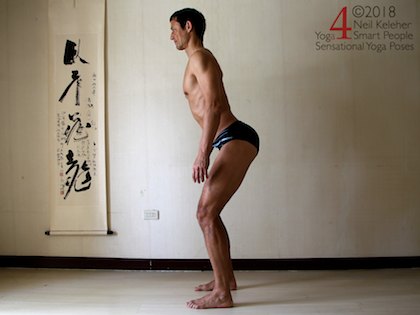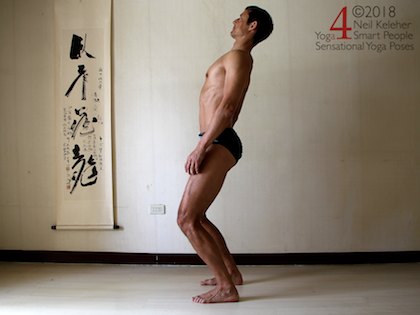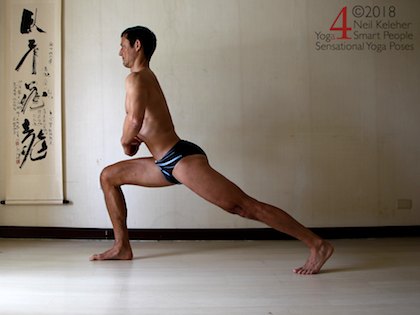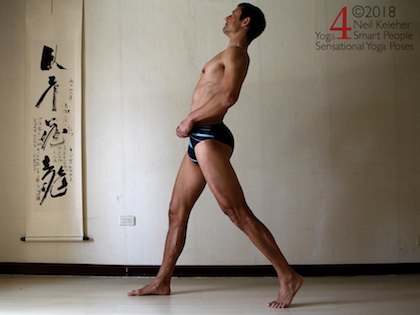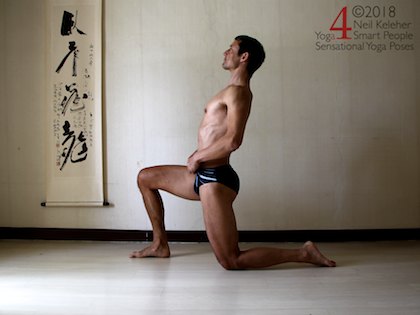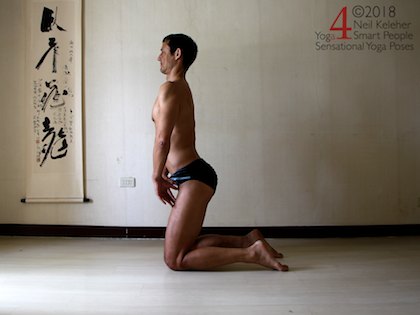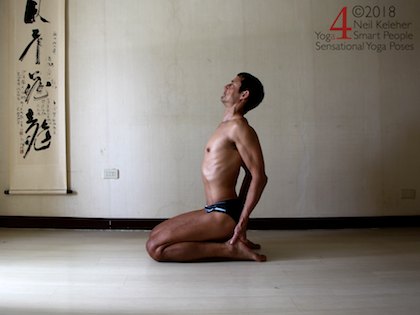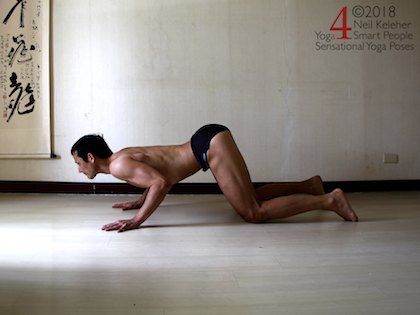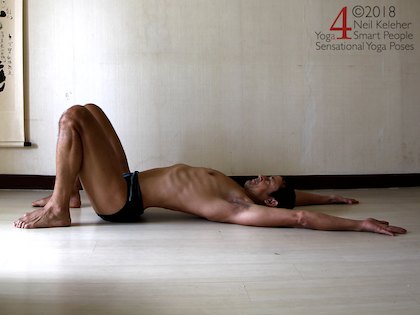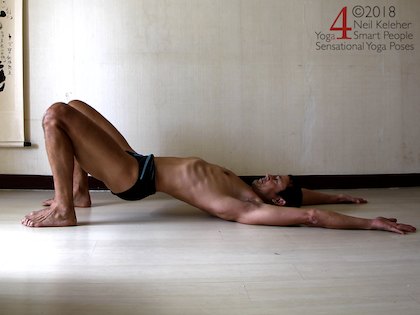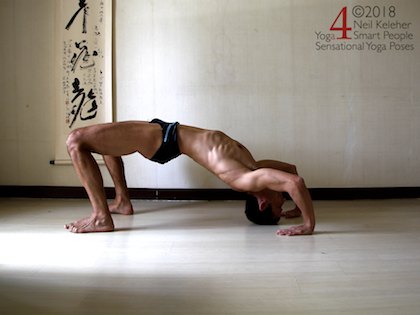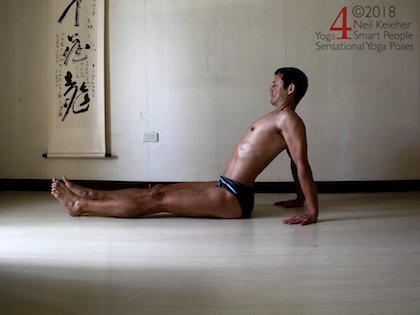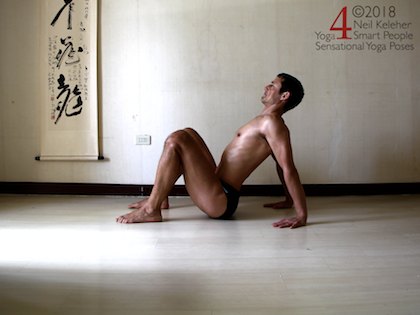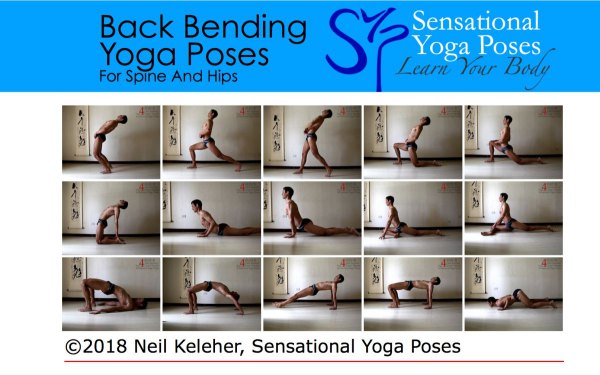Back Bending Yoga Poses for Your Spine and Hips Index

Standing back bend
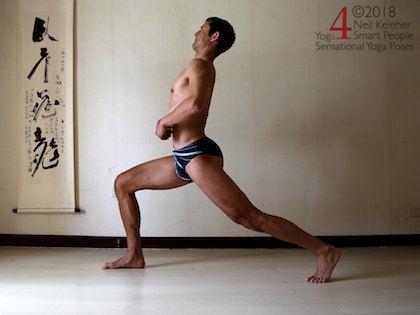
Upright lunging back bend

Straight leg lunge
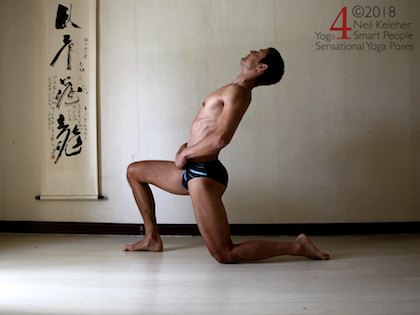
Semi-kneeling lunge

Deep lunge with back bend
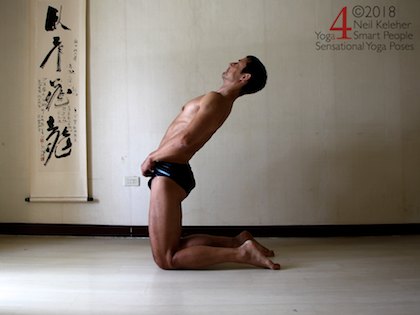
Camel pose variation
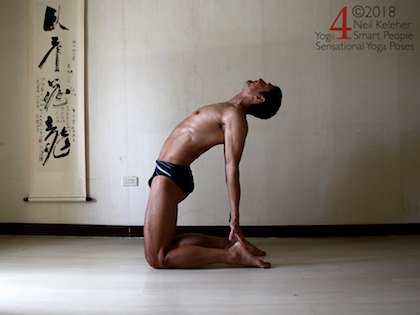
Camel pose w/ hands on heels
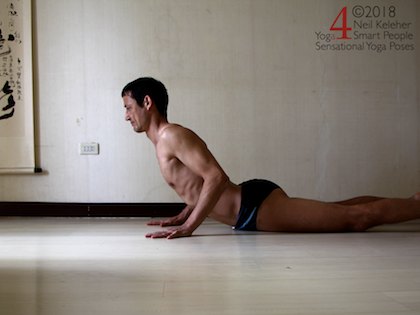
Cobra pose back bend

Up dog back bending pose
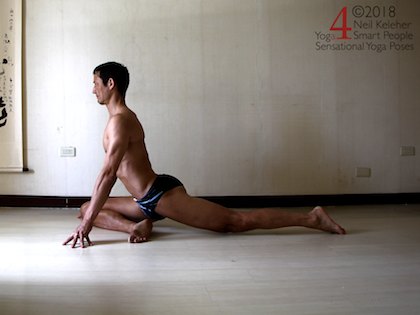
Upright pigeon back bend
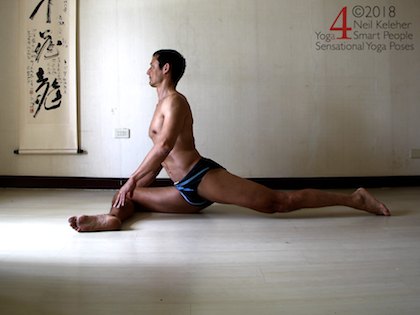
Upright pigeon variation
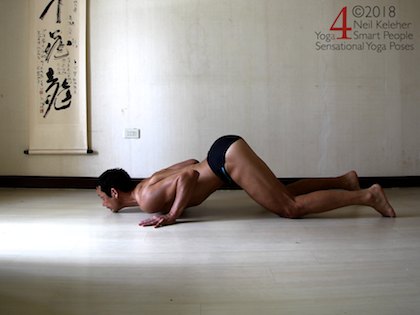
Puppy dog chest stretch
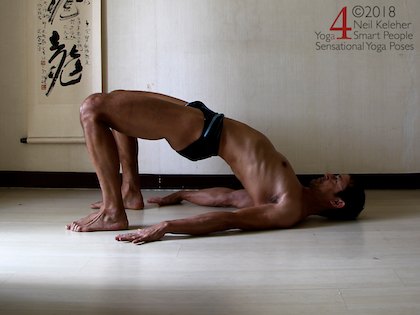
Bridge pose
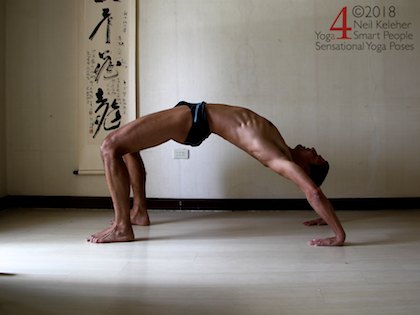
Wheel pose
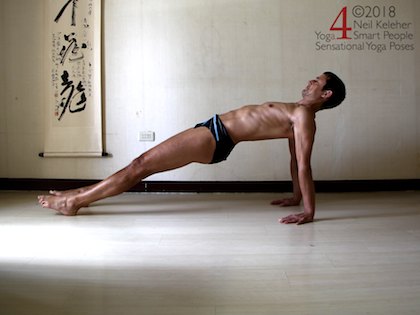
Reverse plank yoga pose
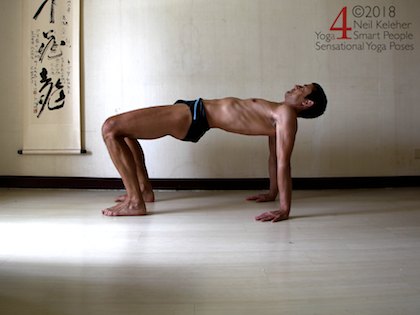
Table top yoga pose
When doing back bending yoga poses, it is important to actively bend your spine backwards using your spinal erectors.
This can be more challenging when your hands and/or feet are on the floor. In these cases, the tendency is to use gravity to drive the back bend. The key is to also use your abs so that your spinal erectors have a force against which to activate.
Activating your spinal erectors (and when needed, your abs) not only helps to keep your spine safe, it also gives you the ability to feel your spine. When you can feel your spinal erectors activating, you can use the sensitivity and control that the provide to adjust your back bending yoga poses.
If a spinal back bending yoga pose also includes a back bend for the hips, then you can help to keep your hips safe by activating your gluteus maximus muscles. Here too, muscle activation helps you to feel your hip joint. With your gluteus maximus (and other hip muscles active) you can adjust the way that you use your hips so that your hip joints feel comfortable.
The exercises in Spinal Back Bending Exercises ideally help you to get a feel for your spinal erectors, gluteus maximus and hamstrings, particularly while bending your spine and hips backwards.
If you've done those exercises, then the challenge can be learning to use those actions together by integrating them sequentially in the yoga poses below.
For this standing back bend the intent is to back bend the spine and both hips.
If this exercise gets too uncomfortable, leave it out.
I left it out for a long time. However, the activations I've included below should help make this exercise more comfortable.
If they don't then leave it out!
Stand with your feet hip width apart, knees and feet pointing forwards and knees bent a little bit or straight.
First lift your tailbone and bend your spine backwards, feeling your spinal erectors/multifidus activating at the back of your sacrum, lumbar spine and thoracic spine.
Keep the back bend in your spine and tilt your pelvis so that your torso leans back.
Keeping your spinal erectors active (and your spine bent backwards), use your gluteus maximus muscles to push your hips forwards.
With gluteus maximus (and hamstrings) and spinal erectors active, you'll be actively bending both your hips and your spine backwards at the same time.
Another approach to this pose is to do the hip thrust first, activating your glutes, then work at bending your spine backwards.
Here again, make sure that you feel your butt and your hamstrings activate.
When bending your spine backwards stat with the intent of "lifting your sacrum" so that your sacral and lumbar multifidus activate (and you can feel them activate).
Then work at using your spinal erectors to bend your lumbar spine and thoracic spine backwards.
Try both approaches and use the one that feels best for you!
In Upright Lunge you can focus on back bending your spine and the hip of the backward reaching leg.
For this pose stand with one leg forwards with the knee bent. Have the other foot back with knee straight and pointing down, heel lifted.
My hands are positioned in the photos below so that you can see my lower back. You can place your hands on your waist or on your front knee when doing this spinal back bending yoga pose!
Start by tilting your pelvis forwards and then bending your spine backwards.
Then, keeping your spinal erectors active and your spine bent backwards, tilt your pelvis back to "extend" the hip of the back leg.
To activate the gluteus maximus (and hamstring) of the back leg you could imagine trying to lift the back leg, or create an upwards pull on it.
Once you are comfortable with bending your spine backwards first and then bending at the hip, try the opposite.
First activate the gluteus maximus and hamstring of the back leg then activate your spinal erectors, starting with the sacrum.
Use the "action sequence" that feels best for you!
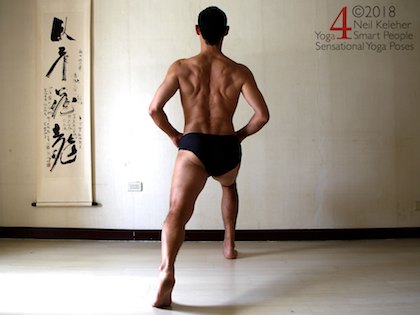
Note the activation of the spinal erectors in this view from the rear!
Another option for the upright lunge that may make it easier to focus on your spinal back bend and bending your hip backwards is to do this pose with the front leg straight.
If bending the spine backwards first, try activating the gluteus maximus and hamstring and then using the tension in these muscles, tilt your pelvis backwards while keeping the spinal back bend.
If activating the gluteus maximus and hamstrings first, after activation, tilt the pelvis backwards.
Then try creating tension at the back of your sacrum prior to using your spinal erectors to bend your lumbar and thoracic spine backwards.
This next spinal back bending pose could be used as a preparation for the yoga spinal back bend called camel pose.
While doing it you can again focus on back bending the spine and extending the hip of the kneeling leg.
Note that "extending the hip" means the same thing as "back bending the hip".
Place one knee on the floor beneath its hip with the other foot forwards in a lunge.
Start by lifting your sacrum and bending your spine backwards, then work at pushing your hips forwards using the gluteus maximus of the kneeling leg.
Alternatively, activate the glute first and your spinal erectors second.
In either case, try to create tension at the back of your sacrum when bending your spine backwards.
Use the variation that feels best for you.
Because both the gluteus maximus and hamstrings can be used to bend the hip backwards, they can also be thought of or termed "Hip Extensor Muscles".
This spinal back bending pose is similiar to the last except that you start with your hips forwards of the kneeling knee and sunk downwards.
Position your front foot so that the front shin is nearly vertical when viewed from the side.
Here, instead of pushing the hips forwards to activate the back leg glute, imagine "lifting" or pulling up on the back thigh.
As you exert your back leg hip extensors you may find that your pelvis to move forwards and downwards.
After activating your back leg, rather than trying to force your spine into a deep back bend, focus on feeling it.
First feel your sacrum, work at lifting it.
Then feel your lumbar spine, work at bending it backwards.
Then feel your thoracic spine.
Carry the sensation of muscular tension at the back of your sacrum and lumbar spine up your thoracic spine so that your ribcage bends backwards also.
Here also experiment with activating your spinal erectors first and then your back leg hip extensors.
For the first version of camel yoga pose, kneel with your hips lifted.
Push your hips forwards using your glutes. As you do so, pull up on your sacrum and as you do so activate your spinal erectors to bend your spine backwards.
You may find this pose a bit easier if your first pull up on your sacrum. Then as you push your hips forwards bend your lumbar and thoracic spine backwards.
Rather than being strict with the sequencing of actions, try to feel your way into this pose. Move slowly and smoothly and don't worry about "backing up".
The end goal is to have your gluteus maximus activated, as well as your spinal erectors, and so sequence the actions in a way that allows you to move to this end goal smoothly and in control with the least amount of effort.
The end pose should feel active but comfortable.
Another version of camel pose is to start with your bum on your heels.
Bend your spine backwards first, then lift your hips and use your glutes to push your hips forwards keeping your spinal erectors active.
As you lift your hips, you can keep your hands on your feet and actually press them against your hands as if resisting your pelvis and chest moving forwards and upwards.
This next set of spinal backbending poses are all "belly down" poses. Here again the idea is to use your spinal erectors, gluteus maximus and hamstrings together for a more or less "whole body" back bend.
Moving back to the floor in prone (belly down) position for cobra yoga pose.
Use your spinal erectors to lift your chest and bend your spine backwards. (locust pose). Then with your hands beside your chest as if doing a push up, keep your spinal erectors activated and use your arms to help lift your chest higher.
Keep your hips on the floor and imagine lifting your thighs to activate your glutes and hamstrings.
You can use a similiar technique in upward facing dog. The main difference between upward dog and cobra is that in upward dog the hips are lifted.
First use your spinal erectors to lift your chest and bend your spine backwards.
Then use your arms to lift your chest, while keeping your spinal erectors active.
Activate your glutes and hamstrings so that your hips continue the back bending action of your spine.
Straighten your elbows and lift your hips, keeping back of the body active.
Your hips may actually move downwards, and perhaps even forwards as a result.
You can do upright yoga pigeon pose with the front hip lifted. Position your front foot rearwards relative to the knee.
If this variation of pigeon hurts your front knee then try the following variation instead (upright pigeon with front hip down).
Try pressing your front knee down into the floor so that your front leg hip is active.
The feeling of spinal back bending and leg activation in this pose is similiar to that in upward dog.
With your torso upright, and hips level from left to right, bend your spine backwards starting with your sacrum.
Then create an upwards pull on your back leg to activate the glute and hamstring of that leg.
You can use your hands to create more of an upwards lift of your torso. But keep your spinal erectors active.
You could also do pigeon with the front hip on the floor, which, depending on the hip flexibility of your front leg may mean you are canted to one side.
Here again, bend your spine backwards, starting with your sacrum, then create an upwards pull on your back leg.
One other belly down pose that you can use to focus on spinal back bending is puppy dog junior.
As you lower your chest to the floor in this "belly down" spinal back bend, work at keeping your spine, including your neck, bent backwards.
The more forwards you hips are relative to your knees, the easier it is to get your chest to the floor in this "chest opening" yoga pose.
This next set of back bends are done with the belly facing upwards.
Lying on your back with knees bent and feet on the floor for bridge pose, you could start of by back bending your spine with your hips still on the floor.
Then try to keep the spinal back bend with your hips slightly lifted.
My hands are reaching rearwards in these photos so that you can see my lower back.
Once you can feel your spine bending backwards with hips slightly lifted, then try it again with your hips pressing up to maximum height.
As you press your hips higher you should feel your gluteus maximus activating towards the top of the pose.
You may find that the more you bend your lumbar spine backwards, the easier it is to use your glutes.
For more on bridge pose you can read bridge yoga pose.
Try to keep your knees and feet pointing straight ahead when using your gluteus maximus.
(Mine are slightly turned out in the photo above.)
More importantly, be aware of how your feet and knees are positioned and notice how that affects the feeling in your hips and around your sacrum and SI Joints.
If doing wheel pose, you can start on the crown of your head and in this position initiate a spinal back bend.
Once you can do that comfortably, then work at keeping the spinal back bend as you lift your head off of the ground.
In other words, keep your spinal erectors (including at the sacrum) active.
As with bridge pose, feel your knees and feet and prevent them from turning out excessively.
For both bridge pose and wheel pose, when you tilt your pelvis forwards as part of activating your spinal erectors, you actually give the gluteus maximus a little bit of a stretch.
You could think of this stretch as giving the gluteus maximus room to contract more effectively.
For reverse plank pose start with a spinal back bend, tilting your pelvis forwards and activating the spinal erectors (or multifidus) at your sacrum.
Then lift your hips while keeping the spinal back bend.
Try a slight hip lift of your first few tries. then as you get better at maintaining the spinal back bend, work at lifting your hips higher.
Work at pressing your heels down to lift your hips (and to help activate your glutes and hamstrings).
For table top pose start with an active spinal back bend. Then lift your hips.
Here the arm position may cause you to lose the back bend in your upper spine, so lift up slowly.
Because of the arm position, the higher you lift in this pose the more you stretch your shoulders with the arms in a backwards position. So you can use this pose as a bonus shoulder stretch.
Even though you may lose the back bend in your thoracic spine, work at keeping it in the lumbar spine and sacral region.
For more back bending yoga poses (that include the hips) check out back bending yoga poses
So how do you counterpose or balance spinal back bends? With spinal forward bends. And those can start with the sacrum also.
For more on "lifting the sacrum" and the muscles involved, as well as the opposing action, take a look at the SI Joint Stabilization article.
Published: 2018 03 24
Updated: 2021 01 24
















